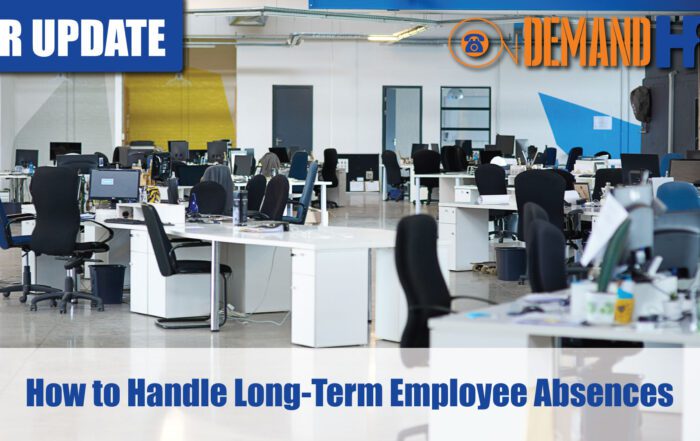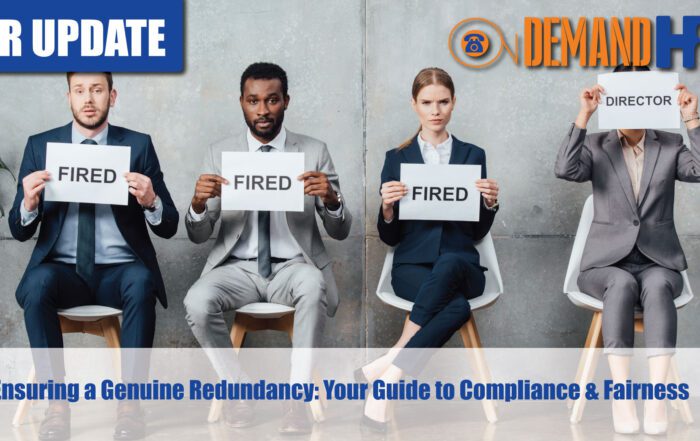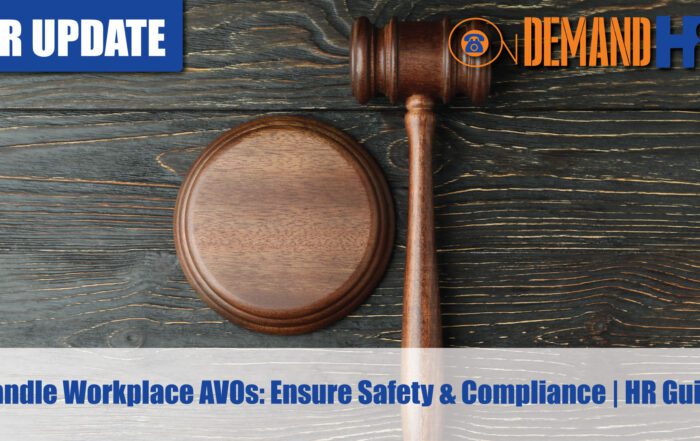Best Practice vs Obligations For Terminations
When providing advice regarding carrying out an effective termination process, we often get the question from client “do I really need to do that?”. We are going to share in our view based on carrying out hundreds of terminations as well as representing businesses in the Fair Work Commission what is best practice and what is absolutely essential when carrying out a termination process.
Please see below for a full transcript of this video
Facing a HR or WR Challenge and need a Free Strategic Action Plan?
Want to access our free online training courses to build your skills?
Share the HR or workplace relations challenge facing your business and one of our experienced consultants will be in touch within 24 hours with a strategic action plan or discover the best strategy yourself by accessing out free online training library.
Transcript
Hi There, and welcome to HR Live . When providing advice regarding carrying out an effective termination process, we often get the question from clients “do I really need to do that?”. We are going to share what in our view, based on carrying out hundreds of terminations as well as representing businesses in the Fair Work Commission what is best practice and what is absolutely essential when carrying out a termination process.
My name is Andrew Koleda, I am the Operations Director of On Demand HR. Since 2010 we been helping businesses of all sizes navigate through Australia’s complex Industrial Relations system. Throughout this time we have appeared in more than 120 matters before the Fair Work Commission and other bodies.
It is really this practical experience that goes well beyond theory which allows us to offer advice and insights which balance risk against the interests of the business. This ultimately leads to decisions and outcomes that are in line with the business objectives, and not simply based on mitigating risk.
HR Live is also a great opportunity for you to put forward any questions around HR or Workplace Relations that your business is facing and if we can, we will answer them live on the stream, however if there is a bit more to unpack we will cover the topic in a future session. Alternatively we give you an opportunity to schedule a free HR Consultation supported by a strategic action plan with one of our experienced HR consultants.
Right, with that out of the way, let’s get into this weeks topic.
If your businesses gets procedural fairness in a termination process wrong, you may find that you are faced with a challenging unfair dismissal or other complaint before the Fair Work commission. So this is really important stuff and the kicker is if you fail in some of these areas, it is entirely possible for the commission to determine that the dismissal was unfair, even if you had a completely valid reason for termination in the first place!
We begin with the letter that is sent to the employee to inform them of a meeting that they are required to attend. There are a couple of components of the correspondence which we feel are essential and some that are not essential but highly recommended based on our experience representing businesses in unfair dismissal proceedings.
Firstly, the letter should contain the usual time, date and location of the meeting but importantly should advise the employee that the meeting is serious in nature where termination of employment is a possibility. In our view, this last component is absolutely essential.
There are a couple of key words that have been selected, the important of which is “possibility”. The Fair Work Act not only requires an employer to give an opportunity for the employee to respond to allegations, but also consider these responses when making their decision. In our view, any other words besides “possibility” could lead to a Commission finding that the decision to terminate is premediated and therefore unfair.
Secondly, in a typical letter we would recommend advising the employee that they are able to bring an independent support person into the meeting. Whilst it is not a requirement to do this, it is highly recommended. This is because the Act requires the business to not refuse to allow a support person to attend a serious meeting. In our view including this in the notification letter is a useful tool to demonstrate the business is following a compliant termination procedure if tested in the future.
Next, we recommend including the main performance or disciplinary issues which have lead to a performance management meeting where termination is a possibility. Again, this is not a requirement but highly recommended as it can serve as a useful tool to demonstrate at a later time what was discussed during the termination meeting.
Finally in terms of the notification letter, we typically recommend that this is sent at least a couple of days, wherever possible, ahead of the meeting taking place. Again this is not essential but it is reasonable in our view to give the employee some time to prepare for the meeting.
During the meeting, we suggest that you prepare a meeting script in advance of the key points regarding the employees performance or conduct that has lead to you considering terminating their employment. Typically we would use the same points that we covered in the meeting letter. Whilst not essential, this step significantly helps the meeting stay on track and not spread into tangents in what is already a stressful situation for all parties involved.
When you are outlining the reasons that the employees performance or conduct is not acceptable it is absolutely essential that you provide the employee an opportunity to respond to any of the points that you put forward. Typically, we will include in the script if the employee is not forthcoming to ask questions such as “do you have anything you would like to add?”. The reason that this is essential is that we are obligated under the Fair Work Act to provide an opportunity for the employee to respond and for those responses to be considered in determining the outcome.
Next is calling a break in the meeting which is not essential but recommended. Typically we recommend calling a break in the meeting after you have discussed the reasons you are not satisfied with the employees performance and conduct and listened to their response. Again, this is important to be able to demonstrate that you have considered the employees responses prior to making a decision to terminate. In our view, calling a break in the meeting prior to making a decision is an excellent way to demonstrate that you have considered their responses. Depending on the complexity of the decision, the break does not have to be long, typically 15-30 minutes may be a good rule of thumb.
When the meeting resumes, you should verbally inform the employee of your decision to terminate their employment. Of course, this step is essential as we are talking about the process of terminating an employee here.
The final thought here, is if the company should have a support or supplementary person present during the meeting. We don’t typically recommend this although we do not have a strong view either way. Essentially, if you feel more comfortable to have another person from the company present during the meeting, then go for it. However please be clear about who is leading the meeting and who is supporting.
Following the conclusion of the meeting, it is essential to follow up the meeting with a written notice of your decision to terminate the employee. We typically recommend that this is sent through to the employee a few hours or the next day, again to demonstrate if required that the decision to terminate was not premediated. This is an essential step as verbal communication can be misinterpreted or reimagined in the future.
So there we have it. That is our summary of the most common questions we get from clients regarding what is essential and what is recommended when it comes to carrying out termination processes.
Please keep in mind that we have not covered whether or not it is a “fair” termination in this update. That is a whole series in itself. Instead we have focused on more the procedural termination requirements under the Fair Work Act which should reduce but certainty not eliminate the possibility of the commission deeming a termination as unfair.
So that’s a wrap for this weeks HR Live Session and really on that you should bookmark and refer back to the next time that your business needs to carry out a termination process. However, if you are facing a particular challenging HR or Workplace Relations situation including termination, please let me introduce a few of the On Demand HR consultants who will tell you a little about our Free HR Consultation supported by a strategic action plan.
Recent Posts
Small Business Employee Termination: Steps to Protect Your Business
Andrew Koleda2024-08-14T14:47:10+10:00HR Guides|
The Essential Guide to Incapacity Terminations: Avoid Costly Mistakes
Andrew Koleda2024-08-14T13:09:32+10:00HR Guides|
Genuine Redundancy Criteria in Australia: A Complete Guide for Businesses
Andrew Koleda2024-05-10T04:39:06+10:00HR Guides|
Protect Your Business: Important Pre-Employment Questions to Remember in Recruitment
Andrew Koleda2024-05-10T04:12:25+10:00HR Guides|
AVOs at Work: How to Protect Your Business and Employees
Andrew Koleda2024-05-09T16:15:15+10:00HR Guides|
Navigating the 2025 Paid Parental Leave Updates in Australia: A Guide for Employers
Andrew Koleda2024-05-09T16:06:56+10:00HR Guides|






